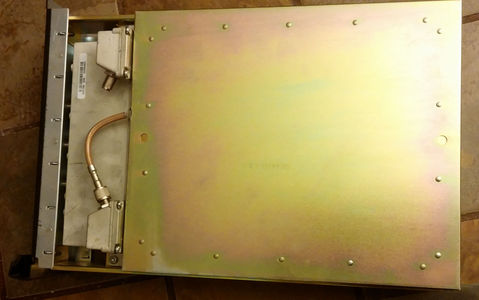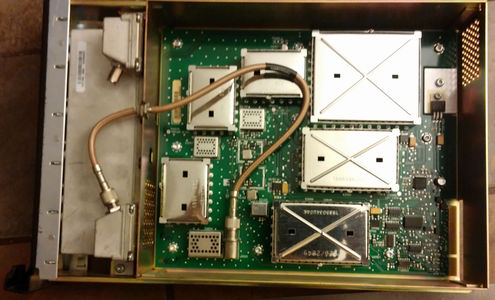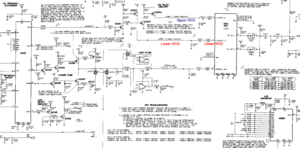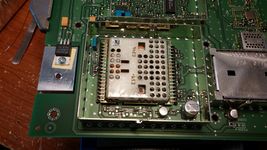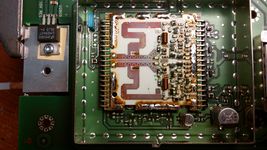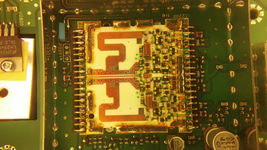UHF Receiver
This page covers the Range 1 to Range 4 receivers. The Range 0 is a newer (and easier to modify) design.
Contents
Basics
The basic receiver is pictured below. Note the UHF R1-R4 receivers have a preselector that's flush with the front panel and only 3 adjustment. This is a dead give away that you have a UHF R1-R4 from the front. Unfortunately there is not an easy way to identify it further than by part number.
The receiver is a high side injection with the 1st Lo operating +73.35 MHz higher than the receiver frequency.
The SCM knows what type of module is inserted by reading voltage divider resistors on the u2600 A/D Converter. Some of these are on ports used for other things, Change Frequency and Lock and then A8 input is used for ID. Note the resistors have the same labels on the UHF boards but on other bands the same parts have different labels. The R2606 and R2607 form a voltage divider feeding the A8 input with the computed voltage in volts.
| Range | R2449 Chg Freq | R2450 Lock | SPACE | R2606 | R2607 | A8 Volts |
|---|---|---|---|---|---|---|
| UHF R0 | 0 | 3300 | 5600 | 3300 | 1.9 | |
| UHF R1 | 0 | 0 | 1200 | 1200 | 2.5 | |
| UHF R2 | 0 | 3300 | 1200 | 1200 | 2.5 | |
| UHF R3 | 3300 | 0 | 1200 | 1200 | 2.5 | |
| UHF R4 | 3300 | 3300 | 1200 | 1200 | 2.5 | |
| VHF | R2413 | R2415 | R2812 | R2814 | ||
| VHF R1 | 0 | 0 | 2700 | 1200 | 1.5 | |
| VHF R2 | 0 | 3300 | 2700 | 1200 | 1.5 | |
| 800/900 | R2422 | R2414 | R2816 | R2815 | ||
| 900 | 0 | 0 | 1200 | 4700 | 4.0 | |
| 800 | 0 | 0 | 1200 | 2700 | 3.5 |
The service manual excerpt is in PDF and below.
UHF Receiver Models TRE6281-TRE6282-TRE6283-TRE6284 Service Manual Excerpt
In PNG format.
Note on the schematic the VCO high and Low are reversed. This seems to be a recurring theme in the Quantar manuals.
As the VCO runs at 73.35 MHz higher than the intended receive frequency the VCO will expect to lock over the following ranges. The ideal spot for the VCO to operate is between 2.5 and 7.5 Volts highlighted in pink below.
| Range | Lower VCO | Upper VCO | ||||||||
|---|---|---|---|---|---|---|---|---|---|---|
| Volts | 0.8 | 2.5 | 5.0 | 7.5 | 9.2 | 0.8 | 2.5 | 5.0 | 7.5 | 9.2 |
| UHF R1 | 462 | 467 | 479 | 491 | 499 | 478 | 491 | 499 | 506 | 514 |
| UHF R2 | 498 | 511 | 519 | 527 | 536 | 514 | 527 | 535 | 543 | 552 |
| UHF R3 | 528 | 543 | 549 | 555 | 564 | 541 | 555 | 561 | 567 | 575 |
| UHF R4 | 553 | 567 | 574 | 580 | 589 | 568 | 580 | 587 | 593 | 601 |
The VCO is much like the VCO in the exciter, a sealed unit with no further diagram available from the factory.
Conversions
Converting the boards
This is changing, I have a better way, old method.
R1 to R2
This is the conversion we're focused on as there are tons of 403-433 MHz (US Federal) Range 1 units on the market for cheap.
In general you should have the following to work on this:
- Soldering iron with fine tip (Metcal suggested)
- Hot air station
- Under board heater
- Small tools/tweezers
- Flux, and other small parts for rework
- Quantar backplane extender cables (PCI extender cables cut down to fit)
Almost needed, you really should have it, but can do without:
- Voltmeter
- Service monitor/SINAD meter
- RJ-9 speaker to SINAD meter input cable.
Nice to have:
- Bench DVM
- Bench PSU
- Spectrum Analyzer and probes
Procedure Overview
In general the VCO (both) need to be moved up in frequency and the image filters from the mixer need to be moved up by changing some chip caps. The ID resistors of the board must be changed to identify the receiver as Range 2 as well. Prior procedures required a bunch of manual power supplies, sweeping the circuit, and monitoring with a spectrum analyzer. This procedure uses the Quantar to control the receiver as it's being worked on using an extender cable.
Preparation
First lets prep the setup and get some notes on the receiver before we move it.
Setup the Quantar and install the extender cables.
Remove the receiver from it's housing.
Install the board in the holder.
Hook it up to the backplane and program in the Range 1 test codeplug.
Sweep and record the VCO steering voltage on each channel where it locks. If not using a voltmeter, you can use the measurement screen in RSS to see the steering level. This is very important as it gives a base line of performance on the receiver before modification.
Tables Generator
LaTeX HTML Text Markdown MediaWiki
Result (click "Generate" to refresh) Copy to clipboard
| Lower VCO | Upper VCO | |||||||||||||||
|---|---|---|---|---|---|---|---|---|---|---|---|---|---|---|---|---|
| Channel | 1 | 2 | 3 | 4 | 5 | 6 | 7 | 8 | 9 | 10 | 11 | 12 | 13 | 14 | 15 | 16 |
| R1 | 384.5250 | 388.2250 | 391.9250 | 395.6250 | 399.3250 | 403.0250 | 410.5000 | 417.9750 | 418.0250 | 425.5000 | 432.9750 | 436.8000 | 440.6250 | 444.4500 | 448.2750 | 452.1000 |
| R2 | 417.9000 | 421.9250 | 425.9500 | 429.9750 | 434.0000 | 438.0250 | 446.0000 | 453.9750 | 454.0250 | 462.0000 | 469.9750 | 474.1250 | 478.2750 | 482.4250 | 486.5750 | 490.7250 |
| R1 Shield on | UNLOCK | UNLOCK | 1.813 | 2.504 | 3.248 | 4.029 | 5.678 | 7.379 | 3.843 | 5.495 | 7.204 | 8.089 | 8.982 | UNLOCK | UNLOCK | UNLOCK |
| R1 Shield Off | UNLOCK | 1.808 | 2.480 | 3.203 | 3.962 | 4.743 | 6.376 | 8.045 | 4.735 | 6.395 | 8.084 | 8.959 | UNLOCK | UNLOCK | UNLOCK | UNLOCK |
| Delta | 0.667 | 0.699 | 0.714 | 0.714 | 0.698 | 0.666 | 0.892 | 0.900 | 0.880 | 0.870 | ||||||
| R1 SINAD | -120.1 | -120.1 | -120.0 | -120.1 | -120.1 | -120.2 | -120.0 | -120.0 | -120.0 | -119.4 | 119.4 | |||||
| R2 Shield On | UNLOCK | UNLOCK | 1.328 | 2.056 | 2.876 | 3.766 | 5.680 | 7.727 | 2.319 | 4.001 | 5.890 | 6.920 | 7.968 | 9.027 | UNLOCK | UNLOCK |
| R2 SINAD | ||||||||||||||||
R3 to R2
No data on this yet. Should be doable, VCO will be a problem.
R4 to R2
No data on this yet, may be doable VCO will be a problem.


